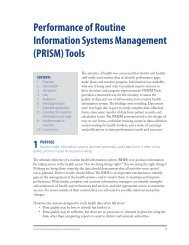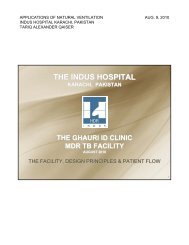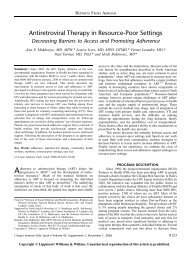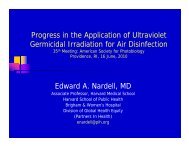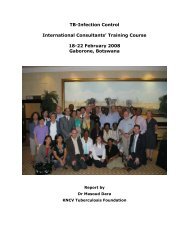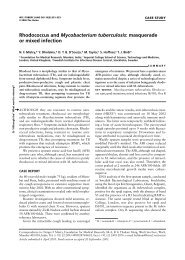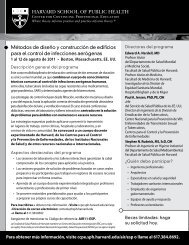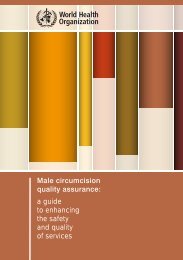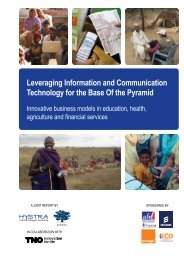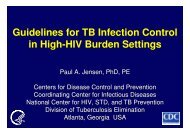Liquid vs. solid culture for tuberculosis: performance ... - GHDonline
Liquid vs. solid culture for tuberculosis: performance ... - GHDonline
Liquid vs. solid culture for tuberculosis: performance ... - GHDonline
Create successful ePaper yourself
Turn your PDF publications into a flip-book with our unique Google optimized e-Paper software.
MGIT <strong>vs</strong>. L J in gold mines in South Africa 1029<br />
<strong>culture</strong> decreased from US$16.62 to US$16.53 (Table<br />
5). Costs per additional M. <strong>tuberculosis</strong> confirmed<br />
with cording were likewise altered from US$328.10 to<br />
US$302.33 <strong>for</strong> MGIT and US$109.07 to US$107.48<br />
<strong>for</strong> MGIT+LJ <strong>vs</strong>. LJ alone.<br />
In a high-cost scenario (50% throughput on MGIT<br />
and overheads increased to 25%), the cost per<br />
<strong>culture</strong> <strong>for</strong> LJ, MGIT and MGIT+LJ increased<br />
from respectively US$12.35 to US$13.04, US$16.62<br />
to US$18.66 and US$19.29 to US$21.65. The cost<br />
per additional M. <strong>tuberculosis</strong> case confirmed with<br />
cording changed from respectively US$328.10 to<br />
US$428.87 and US$109.07 to US$135.18 <strong>for</strong> MGIT<br />
and MGIT+LJ.<br />
In scenarios assuming a reduction in contamination<br />
rates from 16% to 4% of MGIT <strong>culture</strong>s (assuming<br />
75% throughput and 5% overheads), the<br />
cost per additional M. <strong>tuberculosis</strong> case identified<br />
<strong>for</strong> 1) MGIT alone and 2) MGIT+LJ using standard<br />
biochemical tests, anti-MPB64 assay and cording was<br />
respectively US$248.06 and US$135.19; US$180.06<br />
and US$105.22; and US$135.79 and US$84.68<br />
(T able 5).<br />
Changes in discount rates (from 3% to 6%) did<br />
not show significant changes in cost per <strong>culture</strong> and<br />
cost-effectiveness ratios (data not shown).<br />
DISCUSSION<br />
The World Health Organization now recommends<br />
expanded use of liquid <strong>culture</strong> systems in resourceconstrained<br />
settings; 22 our data are among the first to<br />
document how these systems per<strong>for</strong>m in a routine<br />
laboratory in such a setting. The higher yield and<br />
shorter time to positive <strong>culture</strong> with MGIT, particularly<br />
among smear-negative specimens, were expected<br />
and consistent with other work. 7,8,23–25 Less expected<br />
was the high yield of NTM, accounting <strong>for</strong> three quarters<br />
of mycobacterial isolates from specimens positive<br />
on MGIT but not on LJ. The proportion of NTM<br />
in our study was higher than reported from similar<br />
studies in Taiwan, Thailand and Zambia. 7,8,26 M. kansasii<br />
was relatively common among gold miners in<br />
South Africa both be<strong>for</strong>e 27–29 and after the introduction<br />
of MGIT <strong>culture</strong> systems, 30 but was more common<br />
in individuals with a previous history of TB or<br />
silicosis. More recently, among children with suspected<br />
TB in the Western Cape of South Africa investigated<br />
with induced sputum and gastric lavage specimens<br />
<strong>culture</strong>d on MGIT, one third of positive mycobacterial<br />
<strong>culture</strong>s were NTM, primarily M. avium complex<br />
and M. gastri; 31 95% of these children were symptomatic<br />
(reflecting selection criteria). The clinical significance<br />
of the NTM isolates in our study is currently<br />
under investigation.<br />
The high frequency of NTM underlines the importance<br />
of simple, rapid tests <strong>for</strong> species identification in<br />
combination with liquid <strong>culture</strong> media. Microscopic<br />
cording and the anti-MPB64 assay both per<strong>for</strong>med<br />
very well when compared with standard biochemical<br />
tests, consistent with previous studies, 14,15,19 but our<br />
results go further to show that these tests (particularly<br />
microscopic cording) were both less labour intensive<br />
and cheaper, making them particularly suitable<br />
<strong>for</strong> resource-constrained settings.<br />
A limitation in the use of MGIT is the relatively<br />
high proportion of <strong>culture</strong>s contaminated, reported<br />
at 5.5%–15% in high-income settings 6,7,23–24 and at<br />
29.3% in Zambia. 8 This generally improves with experience<br />
of the system, 32 but our data illustrate the financial<br />
benefits of optimising the decontamination<br />
protocol to improve costs and cost-effectiveness. The<br />
cost per additional M. <strong>tuberculosis</strong> detected using<br />
MGIT <strong>vs</strong>. LJ was substantially lower when contamination<br />
was reduced from 16% to 4%.<br />
Our costs per <strong>culture</strong> were lower than estimates<br />
from a similar study in Zambia, 33 where base-case<br />
throughput was substantially lower and overhead<br />
costs, which included transport and all resources not<br />
directly involved in per<strong>for</strong>ming the <strong>culture</strong>, were substantially<br />
higher. Comparable costs (i.e., excluding<br />
transport) in our study were slightly higher than estimates<br />
from Brazil; 34 this may be due to the assumption<br />
of available infrastructure capacity with no additional<br />
cost used in the Brazil study. The <strong>culture</strong><br />
processing costs in our study (medical consumables,<br />
medical equipment and staff time used in per<strong>for</strong>ming<br />
<strong>culture</strong>s) accounted <strong>for</strong> respectively 74% and 82% of<br />
our total cost per <strong>culture</strong> <strong>for</strong> LJ and MGIT. We found<br />
improved cost-effectiveness, particularly in the scenario<br />
with high MGIT contamination, if both MGIT<br />
and LJ were used <strong>vs</strong>. MGIT alone, because having two<br />
<strong>culture</strong>s reduced the probability of a ‘contaminated’<br />
result.<br />
MGIT costs were also sensitive to throughput, with<br />
estimated costs <strong>for</strong> maximum throughput reflecting<br />
the costs that would be expected under operational<br />
conditions in a large routine laboratory. However,<br />
even assuming maximal throughput, the cost per additional<br />
M. <strong>tuberculosis</strong> case detected was substantial,<br />
raising questions about how MGIT technology<br />
should be prioritised in resource-constrained settings.<br />
Our data suggest that minimising the MGIT contamination<br />
rate is key to maximising cost-effectiveness.<br />
Further work will follow up treatment outcomes<br />
based on earlier diagnosis to provide a cost-effectiveness<br />
analysis using cost per life year gained as a final<br />
health outcome, to provide better guidance <strong>for</strong> resource<br />
allocation across differing prevention and treatment<br />
strategies. 35<br />
The high prevalence of M. kansasii among our<br />
study population of gold miners is unlikely to be<br />
generalisable to community TB clinics, and this is a<br />
limitation of our study; in addition, we do not yet<br />
have data on the clinical significance of the NTM<br />
isolates.



